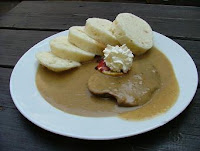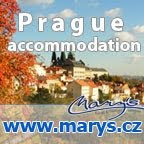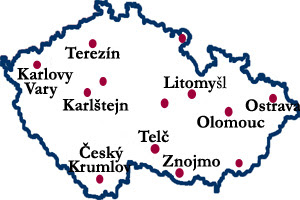

Černčický’s statue has stood immobile in the highest corner of the square for many years, but if it were to come to life, he probably wouldn’t have much trouble finding his way around. The original wooden settlement was largely destroyed by fire in the 1520’s but by 1548, the new owners, the Pernštejn family, had completed a massive reconstruction that fundamentally provided the town with it’s current appearance. The Pernštejns preserved the layout of the rectangular marketplace square and rebuilt the surrounding houses with covered arcades along the front. These covered walkways were an innovation borrowed from Italian renaissance architecture and modified to suit the local conditions and materials. There are other well-preserved examples in world heritage listed towns like Telč and Litomyšl.
The Pernštejns preserved the layout of the rectangular marketplace square and rebuilt the surrounding houses with covered arcades along the front. These covered walkways were an innovation borrowed from Italian renaissance architecture and modified to suit the local conditions and materials. There are other well-preserved examples in world heritage listed towns like Telč and Litomyšl.
The townhouses fronting the marketplace square usually had a shop or workshop on the ground floor and the tradesmen, craftsmen and merchants would present their wares under cover of the arches or in their shops, and live on the floors above. These ground floor workshops usually have gracefully arched ceilings of brick or stone, and are sometimes intricately patterned with ribs and braces or covered with decorative paintwork. Outside, a few of the houses are decorated with renaissance sgraffito (patterns carved through contrasting layers of plaster) but most are painted in plain but cheerful blues, pinks, greens and golds. On the corner of the colourful square diagonally opposite Černčický’s statue, his original fortress has been turned into a romantic renaissance chateau. The exterior appearance, with its round tower and crumbling sgraffito patterns, dates from the 16th Century Pernštejn reconstruction, but the interior has been modernized several times, most recently in the early 20th century.
On the corner of the colourful square diagonally opposite Černčický’s statue, his original fortress has been turned into a romantic renaissance chateau. The exterior appearance, with its round tower and crumbling sgraffito patterns, dates from the 16th Century Pernštejn reconstruction, but the interior has been modernized several times, most recently in the early 20th century.
Learning that the interior of a 16th century chateau was renovated in the 20th century might ordinarily be enough to dissuade visitors, but this project is an exception to that rule, because it was entrusted to an outstanding architect, who brilliantly mastered the task he was set; to preserve and restore the historic elements of the chateau while bringing the interiors up to the highest living standards of the time. Dušan Jurkovič was a Slovakian designer, ethnographer and architect whose best work is an imaginative blend of the Art Nouveau style with Slovakian and Moravian folk art. Apart from the chateau his best-known works in the Czech lands are the spa building at Luhačovice and the Pustevny mountain chalets in the Beskydy hills of eastern Moravia.
Dušan Jurkovič was a Slovakian designer, ethnographer and architect whose best work is an imaginative blend of the Art Nouveau style with Slovakian and Moravian folk art. Apart from the chateau his best-known works in the Czech lands are the spa building at Luhačovice and the Pustevny mountain chalets in the Beskydy hills of eastern Moravia.
One of Jurkovič’s stated aims for the project, which lasted from 1905-1915, was to show that “Czech architects, artists and craftsmen were capable of accomplishing this formidable task without copying or resorting to ideas, workmanship and materials imported from other countries”. As a result the finished interior is something of a gallery of the foremost artists and craftspeople of the early 20th century. Decorative ceramicist Helena Johnova, painters Max Švabinský and Josef Linhart, Art-deco designer František Kysela and sculptor Bohumil Kafka are among those represented.
Thanks to their talent, some of the rooms here quite breathtaking to walk into. Photography is not permitted inside, but it couldn’t have done the spaces justice anyway. If you’re anywhere nearby, it’s well worth calling in to go and see them. This is not one of those chateaus that you can get a good idea about by walking around the outside.
The outside does have its attractions though. The vine-covered courtyard is pleasant, but the gardens at the rear are the highlight of the chateau grounds. The gardens themselves are a formal arrangement of hedges lawns and paths and the many benches offer wonderful views back towards the chateau. The covered wooden bridge that spans the old moat between the chateau and its gardens is another of Jurkovič’s projects, this time in the style that he’s most famous for. The main body of the bridge is the traditional dark wooden architecture typical of mountainous regions, and the architectural details have all been picked out in bright white and some blue. It’s a fairly conservative Jurkovič exterior, but if you want to see a more colourful example you can always go to Hell.
The covered wooden bridge that spans the old moat between the chateau and its gardens is another of Jurkovič’s projects, this time in the style that he’s most famous for. The main body of the bridge is the traditional dark wooden architecture typical of mountainous regions, and the architectural details have all been picked out in bright white and some blue. It’s a fairly conservative Jurkovič exterior, but if you want to see a more colourful example you can always go to Hell.
Which is about 5km north of Nové Město.

The dark wooden body of the building is highlighted and accented with white, green, ochre, pale blue and bright red. That mightn’t sound terribly harmonious, but the colours are carefully balanced and they bring the old wooden building to life like turning on the lights of a Christmas tree. The core of the building is of whitewashed stone and the upper wooden floors and balconies are deep brown with bright white highlights. Beneath the steep shingled roof, the gables are painted in ochre with splashes of red and green and the same ochre is highlighted with bright sky blue under the eaves. To the left of the main entrance and its bright green double doors is a shady outdoor terrace with bench seating for about fifty people and a glimpse of the stream.
The core of the building is of whitewashed stone and the upper wooden floors and balconies are deep brown with bright white highlights. Beneath the steep shingled roof, the gables are painted in ochre with splashes of red and green and the same ochre is highlighted with bright sky blue under the eaves. To the left of the main entrance and its bright green double doors is a shady outdoor terrace with bench seating for about fifty people and a glimpse of the stream. Inside, the high wooden panelling around the walls is capped by a deep shelf and interrupted only by a couple of small windows and the green tiles around the gigantic fireplace.
Inside, the high wooden panelling around the walls is capped by a deep shelf and interrupted only by a couple of small windows and the green tiles around the gigantic fireplace.
From the ceiling of exposed wood hang old fashioned lamps, iron candleholders and traditional marionettes, and the eight or ten tables below are covered by the red tablecloths of the brewery and surrounded by heavy wooden chairs with shapely backs. If there was an award for coziest pub in the country, Peklo would have to be in the running, and it’s well worth making the 5km detour from Nové Město to visit.
Nové Město is in North-east Bohemia, about halfway between Hradec Králové and the Adršpach-Teplice rocks and getting there by public transport is easy. Direct buses from Prague cover the 141km to Nové Město in 2hrs30 for 115Kč. From Olomouc, Ostrava, Brno or Vienna the quickest trips involve a train to Česká Třebova and a bus from there (the buses leave from right in front of the train station).
The chateau is open from 9am to 4pm on weekends in April, 6 days a week May through September, and the helpful tourist information office is open year round.
Tuesday 17 March 2009
Nové Město nad Metují
Subscribe to:
Post Comments (Atom)







No comments:
Post a Comment